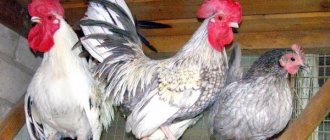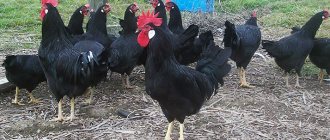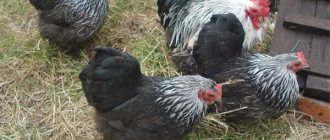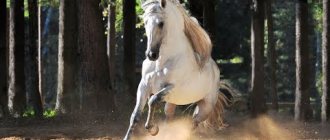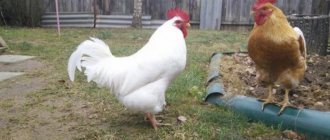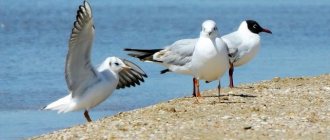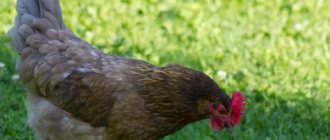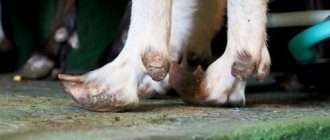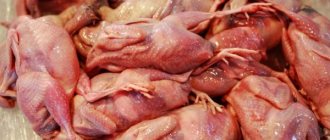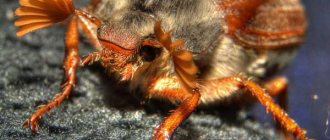Cochin chickens (another name for Shanghai chickens) have been known for several centuries. Despite the fact that in terms of productivity they cannot compete with more modern egg and meat varieties, many backyard owners enjoy breeding these wonderful birds.
The spectacular appearance and endurance of Cochin chickens are highly valued by poultry farmers and breeders around the world.
We will try to understand the characteristics of the breed and the reasons for its stable popularity among domestic and foreign poultry farmers. A general idea of Cochins can be obtained from the table:
| Parameter | Characteristic |
| Class | Birds |
| View | Chickens (Gallus gallus L.) |
| Breed | "Cochin" |
| Productivity type | Decorative |
| Plumage color | Fawn, black, white, blue, marble, etc. |
| Age of puberty | About 8 months |
| Egg production indicators | On average about 110 pieces per year |
| Egg weight | 54-60 g |
| Shell color | Tan |
| Hatchability and survival of young animals | High |
| Growth rate of young animals | Not tall. At 16 weeks of age, chicks weigh about 2.5 kg |
| Live weight of an adult | Hens – up to 4.5 kg, roosters – up to 5.5 kg. The weight of dwarf specimens does not exceed 800 g |
| Consumer qualities of meat and eggs | Excellent |
| Sustainability | The bird tolerates both heat and cold well; hardy and unpretentious |
| Registration in the State Register of the Russian Federation | Only one variety is registered - “Cochin Blue”. Year of registration – 1993 |
| Originators | Federal State Budgetary Institution "Federal Scientific Center for Animal Husbandry-VIZh named after Academician L. K. Ernst", Federal State Budgetary Institution Federal Scientific Center "All-Russian Scientific Research and Technological Institute of Poultry Breeding" RAS, LLC "Genofond" (Moscow region) |
In the photo - chickens of the Cochin Blue breed - the only variety included in the State Register of the Russian Federation
Description of the laying hen's appearance
The body has a rounded shape, with a short neck and a small head, which is crowned with a small erect crest. The “highlight” of the feathered beauty is the fluffy fur coat that covers her from head to toe – just a fluffy little bun.
Even the paws of the quonkas are covered with feather “pants” of bell-bottom style right down to the claws. On top of that, the feathered lady is very tall - she can grow up to 50 cm, and has a weight that ranges from 3 to 4.5 kg.
Treatment of diseases
Cochin chickens, like any other birds, are susceptible to many diseases. Here are the most common ones:
- Salmonellosis . Symptoms: indigestion, weight loss, decreased egg production. The disease is treated with antibiotics, sick birds are isolated, and the premises are treated with disinfectants.
Symptoms: loss of appetite, lethargy, paralysis of limbs, decreased productivity. Tuberculosis is rarely treated because the drugs are expensive.
Tuberculosis.- Pasteurellosis . Symptoms: extreme thirst, lethargy, refusal to eat, stool becomes greenish-yellow with blood in it, and foam may come out of the nose. The young animals die a few days after the first signs appear. For treatment, chickens are given injections of antibiotics and hyperimmune serum.
- Colibacillosis. Symptoms: lethargy, refusal to eat, mucous membranes acquire a bluish tint, birds begin to choke. There is no cure. Sick chickens are sent to slaughter, and healthy ones are given a solution of furatsilin and antibiotics as a preventive measure.
- Parasitic diseases. The main sign of the presence of parasites is diarrhea, sometimes mixed with blood. Such diseases are treated with antiparasitic drugs.
Variety of colors
- White ones are considered the most common. The feathers have a silvery tint. The beak and metatarsus are rich yellow.
- There is a variety of striped Chinese. In this case, each feather is covered with blue stripes, together making up a rather interesting motley “fur coat”.
- Blue ones are covered with feathers without edges. These birds' metatarsals may have a greenish-marsh tint.
- Partridge. Roosters are a little different. Their head is red-brown, and their body is covered with feathers the color of autumn leaves. Ladies in brown-golden “fur coats”, a little lighter.
- They are black with a green tint.
- Fawn have a rich, yellowish tint.
- And the last variety is black and white. The base color of the plumage is black, with white patterns on each feather.
Feeding
Newborn chickens, before they are one and a half months old, are fed the following set of products:
- porridge - soft and semi-liquid;
- fish oil, good for the immune system;
- eggs, finely chopped;
- cottage cheese;
- milk.
From the sixteenth week after birth, the chickens’ diet is made less protein and more carbohydrate.
The diet of adult birds is practically no different from the menu of chickens of other breeds. But it is necessary to take into account the fact that Cochins are more prone to obesity than other breeds.
Compound feed must be present in the feeders at all times. In the summer, birds happily eat fresh green food; in winter it can be replaced with hay. Sprouted grains, boiled carrots, pumpkin, and potatoes are good for chickens.
Chickens can live quite normally, eating leftovers from the table of the farm owners, various wet mash of leftovers. This way, keeping the birds will not cost too much.
However, there is also a minus - it is difficult to calculate the required amount of minerals and vitamins. Therefore, it is better to feed with professional compound feeds, since they have a balanced composition.
Important: if birds begin to get fat, they need to be switched to less high-calorie feeding.
Dwarf cochins
This is a separate species that is different in many ways. Read more in a separate article - the Cochin dwarf chicken breed. In their external features they are similar to their large relatives. They are tiny - the weight of mini-hens is 650-750 g, and the weight of cockerels is 750-850 g. Dwarfs have the same variety of colors, body shape and lush plumage with an abundance of fluff.
The eyes of dwarfs are small, deep-set, and deep red. The bright scarlet comb and earrings are much more developed in roosters than in feathered beauties.
general characteristics
Cochins are attractive chickens that immediately stand out from the rest of the bird population. The physique of these birds is quite large; the roosters are equipped with a chic fluffy tail.
The birds' legs are completely covered with fluffy feathers and look very cute. The head is small compared to the massive body, and has a noticeable bend at the transition to the neck. The bird's beak is yellow.
Their character is phlegmatic: they don’t start fights, they don’t get into trouble. Cochins are usually bred in small private farmsteads. Many people keep chickens of this breed as ornamental ones.
Birds cannot fly, so they do not need high fences. Thanks to their chic and lush plumage, Cochins can easily withstand winter, even the frosty Russian one. However, they cannot be kept in conditions of high humidity: the house must be dry and ventilated.
Sexual maturity and egg nuances
Chinese laying hens mature relatively late. Closer to 1 year, they begin to show pronounced signs of the breed. They begin to lay eggs at about 8 months of age.
However, the eggs of these lush beauties are small - 55 g each. Their shell is light brown. In 1 year, a working woman is able to produce approximately 120 pieces.
In dwarfs, the moment of sexual maturity occurs closer to one year. The crumbs delight their owners with testicles - no more than 30 g each. In one year they are able to lay up to 80 eggs.
Interesting fact
Despite the fact that this is a meat-type breed, in pre-revolutionary Russia it was bred mainly for the purpose of obtaining table eggs. Asians have a distinctive feature - they do not stop their work, and rush even in winter, when other breeds take a break.
After the cold weather passed, the working bird was sent for meat, or, if she was lucky, she was sold as a mother hen, and she copes with this role very well.
Helpful advice
During puberty (up to one year of age), it is worth carefully monitoring the diet, and it is advisable to feed chickens separately from cockerels.
Ladies love to eat, which is why they have a predisposition to become fat. Fat birds take longer to mature and lag behind their feathered neighbors in terms of productivity.
Productivity
Cochin chickens are raised as a meat breed. Adult females reach a weight of 4 kg, males - 5 kg. As a separate point, we would like to mention dwarf Cochins, which grow only up to 1.2 kg and are therefore not interesting for meat breeding.
Chickens grow at an average rate, reaching only 2.5 kg of weight by four months. Their puberty is also delayed, which delays the time for new laying hens to lay eggs. Although Cochin meat is tasty, it is often too fatty. The breed is genetically prone to a strong increase in fat mass.
During the season, one adult chicken produces about 100 eggs, and in winter the birds are more productive in this regard. The weight of one egg reaches 55 grams.
In general, in terms of productivity, Cochins cannot compete with many other modern breeds. Therefore, they are often bred now as a purely decorative breed.
Cochin chickens
Cochin chicks are born with a light fluff, which is even present on the legs, which then develops into a fluffy fur coat with pants. Unlike their shaggy parents, they remain practically “naked” throughout their youth.
Cochin chickens do not require a special diet - they can easily eat traditionally, and according to their age. You can use ready-made industrial food for babies from about a week of age. From the first day you need to independently prepare mixtures of boiled eggs, cereals, and herbs.
On the 2nd day, to strengthen the stomachs and replenish the need for protein, it is recommended to feed small squeakers with yogurt. From the 5th day you can already introduce mineral supplements. It is very important to maintain cleanliness and dryness, and timely process the drinking bowls and feeders of the young generation.
During the first 2.5-3 months. It is recommended to offer high-protein foods and later reduce the amount of protein intake, especially for expectant mothers, to avoid growth pathologies. And they grow very quickly, and by the 4th month. weigh 2.5-.27 kg.
Breeding
Shanghai chickens are excellent brood hens. They have a well-expressed incubation instinct. Even roosters can sit on eggs if they are allowed to do so.
The hen will sit on any eggs that are placed under her. There are cases when Cochins hatched ducks and turkeys. They can also be foster mothers for “abandoned” chicks.
Like other breeds, Cochins lay eggs in the spring. The hen is easy to distinguish:
- clucks often;
- does not come out of the nest;
- fluffs feathers.
The hen is placed in a quiet place and 12-14 eggs from other laying hens are laid. Eggs are chosen that are the same size and age; the weight must be at least 53 grams. Otherwise, it will not be possible to get large offspring.
Chicks begin to hatch after 21-22 days. The offspring are hardy and grow quickly. A Cochin chick weighs 35 grams immediately after hatching. In a week, with proper care, he gains up to 200 grams, in a month - 0.8-1 kg. But then Cochins grow slowly. By 4 months they have gained only half their weight.
The breed is of Asian origin, where it is hot and humid. Therefore, the young fledge slowly and love warmth. For a long time, Cochin chickens walk around completely naked.
Cochins are successfully bred using small incubators. According to reviews from poultry farmers, hatchability in an incubator is 70-75%.
Diet of adult birds
In addition to the fact that these laying hens love to eat well, they have their own culinary preferences. Most of all they love soft food, but it is still worth feeding them dry grain once a day. You can prepare your own wet mash, but in this case you should think about ensuring that the food satisfies all the birds’ needs for vitamins and minerals.
When choosing this type of feeding, do not forget to feed the feathered gourmets dry grain of different types once daily.
Experienced breeders recommend introducing pumpkin and boiled carrots into the diet. Another important nuance is that a chronic deficiency of animal protein in the menu can trigger the development of so-called chicken cannibalism.
This is a pathological manifestation of the instinct of self-preservation, which is observed in almost all representatives of the animal world. But, in your quest to feed your fluffy laying hens well, do not forget to ensure that you do not overeat, as this will inevitably lead to obesity.
Reviews from poultry farmers
Marina, 43 years old, Oryol region
These chickens are my favorite. I have fawns (three females and a cockerel). I don’t do purebred breeding, I keep them solely for the soul. I like both his appearance and his calm character. I don’t remember any problems with them: they eat everything I give, don’t run away, and don’t quarrel with other birds. If you need beauty in the poultry house, I recommend buying these chicks, although the prices for purebred chickens are quite high. But there is a pleasant bonus: such chickens are wonderful hens. They hatch their own eggs and those from other chickens. Last summer I “threw” store-bought chickens to them – they all raised them well together.
Oleg, 39 years old, Moscow region
I keep purebred chickens and breed them. I acquired Cochin dogs not long ago: blue, black and fawn. Now I want to see what colors will be obtained when crossing. I have not noticed any difficulties with the content yet. The only thing is that the birds are quite phlegmatic, they don’t strive for extra exercise, but they love to eat. It is necessary to monitor the calorie content of the feed so that they do not become fat and refuse to lay eggs. And so, the breed is wonderful. Rare beauty, and practically problem-free.
Semyon, 44 years old, Khartsyzsk
If you want “no frills” chickens, then Cochins are the way to go. Calm, unpretentious and beautiful. For several years now, we have been buying young animals in the spring, weighing 300 grams each. To grow faster, we give mixed feed for up to 2 months, then grain mixture, greens, dried nettles, and milk products. They lay all winter, every other day. The eggs are good, quite large. If the hen begins to settle on the masonry, then we send her to the cellar for a while. The meat is tasty, but sometimes it turns out too fatty.
Content Features
As mentioned above, Asians are unpretentious and can withstand life in cages or small enclosures. In this case, it is necessary to ensure that the shaggy beauties do not get exposed to rain, because this will negatively affect the quality of their plumage.
Thanks to their warm coats, they can withstand frosty winters well - they can be kept even in harsh climatic conditions.
A very important fact is that Cochins are not able to fly. When arranging a chicken coop, take this nuance into account - high perches are not suitable for them, because they simply cannot climb them. If there is a possibility of walking, this is only a plus, but the birds feel well without it.
The Chinese woman is able to withstand frost, and this does not affect her well-being or productivity. Recommended temperatures in the chicken coop in winter are 12-15°, humidity 55%.
The minimum permissible is -2°, and the maximum is + 25°. Remember that prolonged overheating is dangerous to health! Poultry houses must be equipped with a good ventilation system, because musty air is an ideal environment for the proliferation of infections.
Origin
According to one version, the birthplace of miracle chickens is the Vietnamese region of Cochin China, and according to another, the territory of modern China. It was from there that they were brought to Europe in the 19th century.
Local farmers immediately fell in love with the new birds, and made them extremely popular, which is not surprising, because luxurious chickens turned out to be beautiful, unpretentious and profitable. This was appreciated not only by poultry farmers, but also by breeders who began to use “Chinese women” in their work on new breeds.
By today's standards, the level of meat productivity of Cochins is below average, because of this they are not bred for the production of chicken on an industrial scale. But these birds are still considered representatives of one of the most beautiful breeds of chickens.
Molting and break in egg production
The annual molt begins in the fall, when daylight hours become shorter. This is a difficult period in their life, and it is worth supporting them with enhanced nutrition, enriched with all the necessary vitamins and minerals.
This “changing of clothes” lasts 25-30 days, and during this time they pause in egg-laying. But this is not the final end of the “career” - along with the plumage, egg production will also be restored. Later, when the hen gets old, she begins to shed with age, and with this a rapid decline in productivity.
History of the breed
The Cochin breed was registered at the beginning of the century before last. Its ancestors were fawn chickens from Indochina; during the selection process they were crossed with Malayan chickens and representatives of European meat and meat-egg breeds. In Europe, the birds quickly gained popularity due to their spectacular appearance. The first Cochins were brought to Russia at the end of the 9th century. They became regular participants in agricultural exhibitions and often received prizes.
Cochin breed - origin
In Europe, selection work on the breed continued. As a result, the chickens received more luxuriant plumage, and the standard fawn coloring was supplemented with other color options. The chickens have become more impressive in size, and their egg production has also improved.
Chickens with beautiful lush plumage
Despite all its advantages, the breed has not found widespread use in industrial poultry farming. Today it is found only in private farmsteads, among poultry collectors and owners of breeding nurseries. Purebred Cochins are quite rare; the cost of adult chickens, young animals and eggs is high.
Cochin chicken breed
Photo
We described the breeds of chickens above, and now we offer you to look at them in photographs.
Brahma
Cochin
Which one is better for meat and which one is better for eggs?
Both breeds are meat breeds . Initially, bramas were bred as heavyweight meat breeds (roosters reached 7 kg), but then producers focused on decorative qualities at the expense of productivity.
Brama, like Cochins, has high quality meat. But given the tendency of Cochins to become obese, their meat may not be as dietary as that of Brahma.
Despite the fact that both breeds are meat-oriented, they lay eggs well in winter, producing 100-120 eggs per year for Brahma and 120-150 eggs per year for Cochins.
Incubation
For incubation, it is necessary to select eggs weighing at least 30 grams: smaller ones will not produce chicks. The rest of the recommendations are standard.
Table of temperature and humidity modes
| Period |
